If you know anything about the history of the companies mentioned in the text or know the connection between them, I'd really like to hear from you. Registered in 1800, they seem to have gone from exporting machines all over the world around the beginning of the 20th century to complete obscurity.
Introduction
This page was produced because Eric Brain, who has been emailing me on and off for 20 years, emailed me in June 2022 asking about Mackies Engineering in Kingswood.
I cannot find any sort of potted history of the company anywhere and am not yet sure of the connection between Mackies Engineering of Berks Iron Works, Caversham Road, Reading; Mackies Engineering of Kingswood Hill Engineering Works, Hill Street, Kingswood, Bristol, Mackies Ltd.; and Mackies (1921) Ltd.
One thing these companies have in common is that they were involved in making machinery for agriculture and farming.
The Institution of Mechanical Engineers Proceedings of 1896 (parts 3-4) says that Mackies were based in Reading at least in 1894. I was beginning to think that Mackies, Reading specialized in pumps and sprayers but The Universal Electrical Directory of 1900 has the following:
Mackies, Ltd., electrical engineers, manufacturers of wrought iron spring pulleys, turned shafting, standards, brackets, bearing, &c., Berks Iron Works, Reading. (Telegrams: "Machinery, Reading" Telephone No. 86) Registered May 10, 1800. Directors: J. B. Mackie, Esq. (chairman); H. R. Sutton, Esq. (secretary); & Herbert Sutton, Esq.
Mackies were still at Reading in a 1913 directory.
The Oil and Colour Trades Journal, Volume LIX (59) of 1921 says that
Mackies (1921), Ltd. - Reg. No. 173,380 (R.C.) £10,000. (V) £1 (O) To acquire the goodwill (other than in relation to Strawson spraying machines) of Mackies, Ltd. (now in liquidation). formerly of Cavendish Rd., Reading; to aquire the business of John Robinson & Co., of Hill St., Kingswood. Glos.; to purchase a portion of the premises formerly known as "The Kingswood Hill Engineering Works." Hill St., Kingswood, to manufacture Strawson spraying machines and the Robinson Patent Skiving Machines on royalties, and to carry on the business of mechanical engineers and foundrymen, etc. (R.O.) Kingswood Hill Engineering Works. Hill St., Kingswood (P.C.)
At least they provided a key: (O) - objects; (P.C.) - Private Company; (R.C.) - Registered Capital; (R.O.) - Registered Office; (V) - Value of shares
This information is interesting because it mentions the Robinson Patent Skiving Machine. A skiving machine is used in leatherwork to remove thin layers, a little like planing wood. John Robinson of Park Road, Kingswood took out US patent 1,388,971 for his skiving machine. He applied for it on December 10, 1919 and was granted it on August 30, 1921. It appears that one half of the patent was assigned to Hodge, Jacques & Co. Ltd. of Bristol.
Hodge, Jacques & Co. Ltd. were located at 16, Lower Castle Street, Bristol and specialized in belting and power transmission. They were established in 1908 and incorporated as a Limited Company in 1915. In 1922, the directors were H. S. Hodge and H. I. Jacques.
Mackies were listed at being at Hill St., Kingswood in Kelly's 1926 Directory.
I came across a couple of threads Indentification of engine and Update on Identification of engine on the SmokStak website dedicated to antique engines that mention Mackies (1921) Ltd.
The threads say that someone had a "mid 1920s 1½ hp open crank petrol-paraffin" engine, and that "The crankshaft is supported on ball bearings" and that it had "ball bearing main bearings, a completely open crank with a light tin splashguard." It seems the engine was built by Hobbs of Frome, Somerset around 1922 and distruted by Mackies (1921), Ltd. of Kingswood. Unfortunately the images accompanying the text are long gone and were not collected by the Internet Archive.
Advertising
These companies advertised heavily in several trade magazines and some of these are presented here:
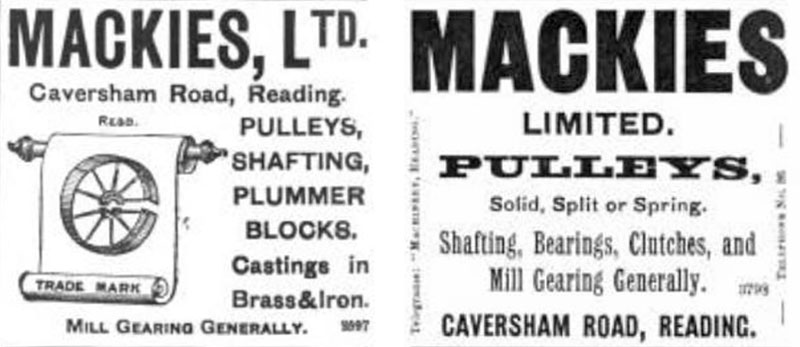
Mackies
Enginering, July and December issues of Engineering, 1899
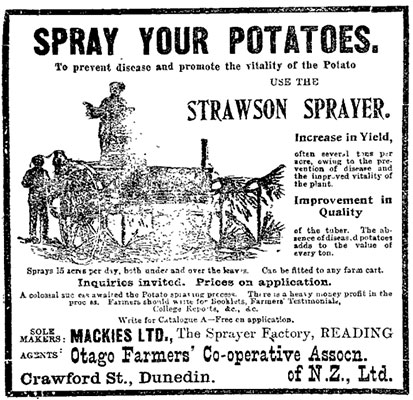
Mackies Strawson Sprayer
Otago Witness, February 5, 1908
From the above advert, Mackies were sole manufacturers of the Strawson sprayers and were exporting them to New Zealand
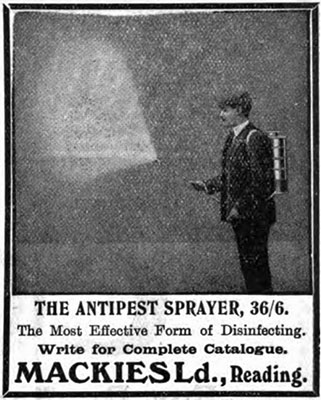
Mackies Antipest Sprayer
Sanitary Record, July 7, 1910
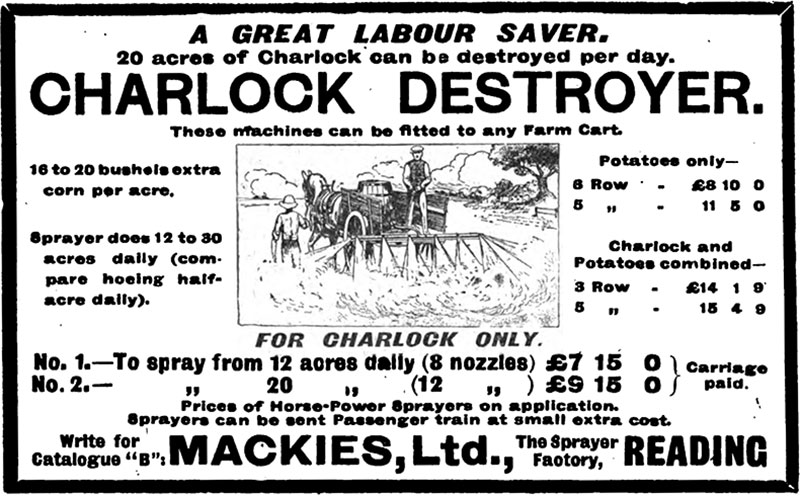
Mackies Charlock Sprayer
Agricultural Gazette, May 1, 1916
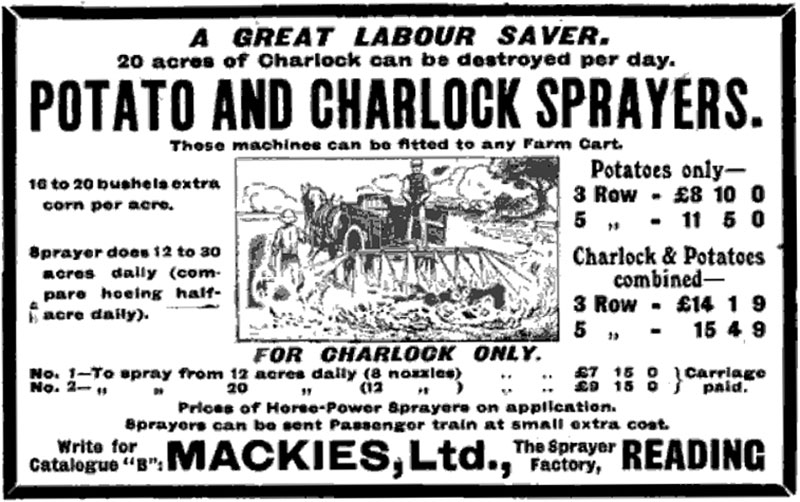
Mackies Charlock Sprayer
Agricultural Gazette, June 26, 1916
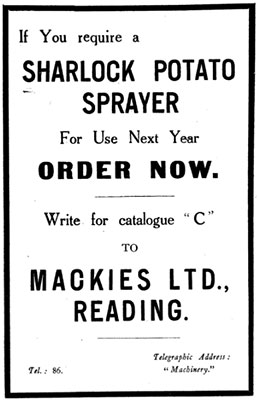
Mackies Potato Sprayer
Farming on Factory Lines by T. Wibberley NDA NDD, 1917
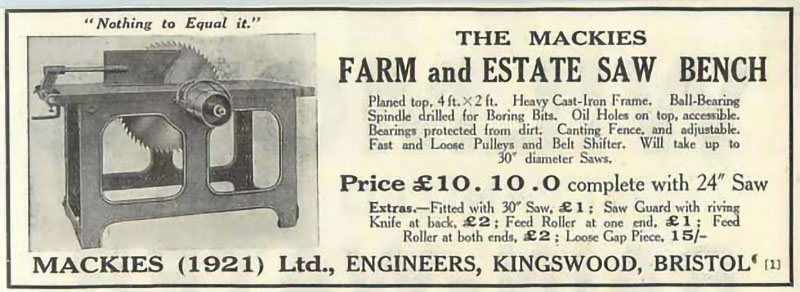
Mackies (1921) Saw Bench
Advert from 1926
Strawson's Charlock Destroyer
Charlock is a a type of wild mustard and difficult to eradicate. Around 1900, the method of ridding fields of it was to spray it with a solution of iron sulphate and copper sulphate.
The September, 1899 Queensland Agricultural Journal describes an experiment held on May 17, 1899 at the farm of the Agricultural College at Uckfield, Sussex:
Mr. Strawson brought down his new charlock destroyer, which covers a width of 24 feet with its movable arms, which can be folded to pass through a gateway. The price of this is £8, or 30s. under the ordinary cart sprayer. As, however, the latter, although taking a somewhat smaller width, is fitted with adjustable nozzles for underleaf work, by means of which it can be used for any other spraying work, such as potato spraying, together with other accessories, the latter machine can hardly be superseded by a special form for spraying charlock alone. It will be noted that, for spraying charlock, top nozzles only are required.
The 1990 Complete Grazier describes the machine, Strawson's Charlock Destroyer, invented by Mr. G. F. Strawson of London which looks very much like the machine depicted in Mackies' 1915 advertising.
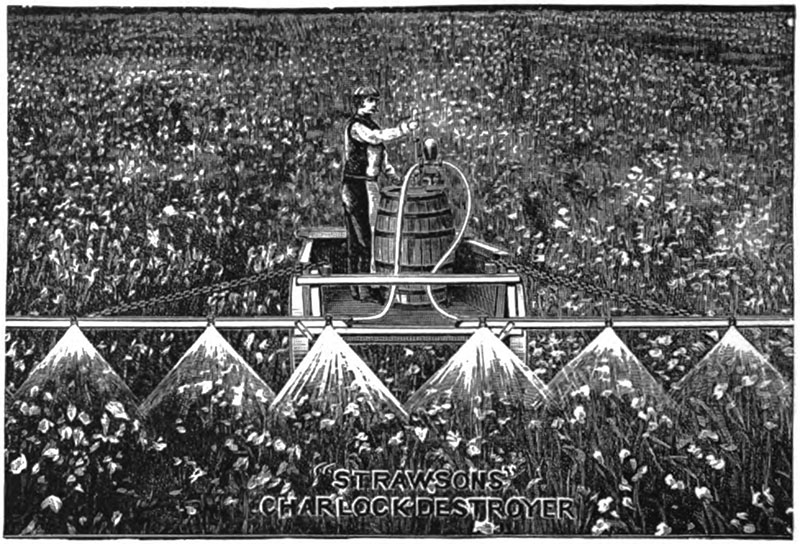
Strawson's Charlock Destroyer
Complete Grazier, 1900
No machine has excited more interest during the last few years than the Strawsonizer invented by Mr. G. F. Strawson, 7IA, Queen Victoria Street, London, E.C. It is entirely a new implement on the farm and is constructed with the view of serving as a manure distributor, a corn broadcaster, and, particularly, for sprinkling or spraying powders or liquids upon plants infested with insect or fungus pests.
The appliance, which acts on the fan principle, is made in several different forms to adapt it for spraying vines, hops, fruit trees, coffee-plants, &c. The same inventor has introduced an ingenious knapsack spraying apparatus, called the "Antipest."
In 1899 he brought out the Charlock Destroyer, fitted with nozzles which emit a fine spray 18 feet wide. A long folding support adjusted to the back of a farm cart carries the spray nozzles, which are connected to the pump by tubing. The pump is fitted automatically on a barrel, and the whole is easily operated by one man. The machine will deliver any required quantity of sulphate of copper solution, or other liquid, per acre.
Volume I of the Stockbreeder's Magazine also commentated on Strawson's Charlock Destroyer:
Mr. Strawson, who has been so closely identified with spraying machines since he brought out the Strawsonizer, some years ago, recognised the necessity, and had provided machines specially adapted to requirements. Recognising that expensive machines would not be popular, he brought out efficient machines, taking breadths up to 24 ft., at a cost of £8, and, as such, capable of dealing with 30 or more acres per day. The Charlock Destroyer is very simple in construction. A 40-gallon petroleum barrel is fixed in a cart, and on this a hand-pump of sufficient power is placed. The liquid is forced through two rubber tubes into two copper tubes fixed at the back of the cart, and extending right and left, so as to cover the space required. The copper tubes, which carry the eight nozzles, are supported on light wooden arms; and these are, in their turn, carried on a light frame, which is attachable in a few minutes to any farm cart. There are no intricacies, and, once the machine is set going, it is as easy to manipulate as a road watering cart.
Another machine is made so as to be applicable also to the spraying of potatoes, producing upward as well as downward spray, as is desired, and they can be worked independently or collectively. This, too, is a cart sprayer. A smaller machine, taking a width of 9 ft., called the twin-sprayer, carrying three nozzles, is carried by two men. This is a useful machine for small acreages, far superior to a knapsack. Mr. Strawson is going to put this on to wheels next year, when it will doubtless become a very popular machine for ordinary farms.
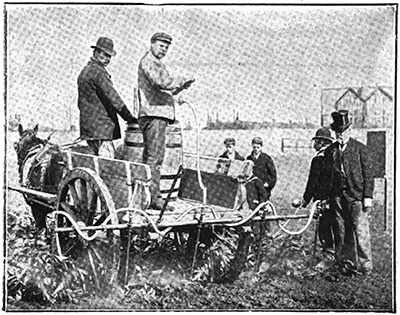
Strawson's 9ft. Twin-Sprayer
Stockbreeder's Magazine
The Royal Agricultural Society Journal of 1910 reported that at the Fruit Tree Spraying Trials held at Hucclecote, Gloucestershire on June 17 and 18, 1909, that Mackies, Ltd., entered a "machine made to be carried or wheeled. It had a brass pump with ball valves fitted in an 18-gallon oak barrel. The pump was easy working and could easily be removed for inspection."
Sources
Agricultural Gazette - 1916 Editions
Complete Grazier - 1900 Edition
Engineering - Volume LXVIII, July - December, 1899
Farming on Factory Lines by T. Wibberley NDA NDD, 1917
Grace's Guide To British Industrial History - A fantastic resource for historical information on industry and manufacturing in the UK
The Oil and Colour Trades Journal - Volume LIX (59) of 1921
Otago Witness - February 5, 1908
Queensland Agricultural Journal - Volume V, July - December 1899
Royal Agricultural Society Journal - 1910
Sanitary Record - Volume XLVI, July - December, 1910
Stockbreeder's Magazine - Volume 1
The Universal Electrical Directory - 1900
This page created June 14, 2022; last modified June 18, 2022








